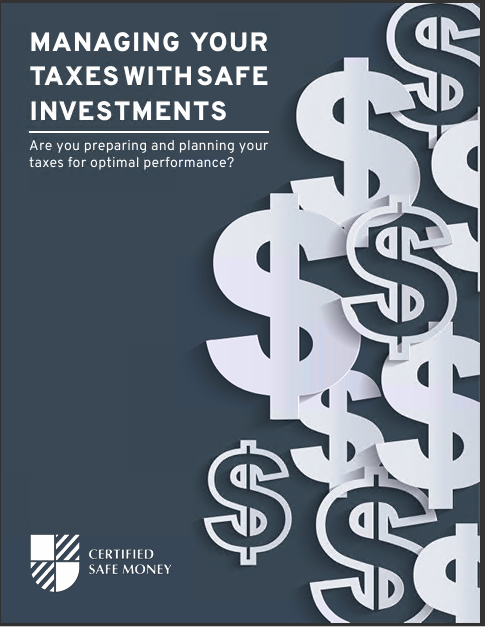Guaranteed Retirement Income Guaranteed Lifetime Income in Retirement
A successful retirement plan should include one or more streams of guaranteed income that ideally will last for the remainder of your lifetime. Today, due in large part to a volatile stock market, low-interest rates, and longevity, one of the biggest fears on the minds of retirees (as well as those who are still planning for retirement) is running out of money while they still need it. The good news is that there are ways to create and maximize guaranteed lifetime income in retirement – provided that all of the components of the strategy are properly put in place. This is where a retirement income specialist can help.
Find the most credible, highest-rated Safe Money advisors in your area.
If you are nearing retirement or already retired, you should consider safe money because your future is too bright to risk. Are you a safe money expert?
Is Your Retirement Income Guaranteed?
Chances are that you will be able to count on at least some guaranteed lifetime retirement income. For instance, many people rely on lifetime cash flow from one or more of the following sources:
- Social Security
- Employer-sponsored defined benefit pension plan
But unfortunately, even if you qualify, these sources alone may not be nearly enough in the future. For example, according to the Social Security Administration, an average wage earner will typically only replace about 40% of their pre-retirement income with these benefits. For higher wage earners, this replacement percentage of Social Security benefits can be significantly lower. Over the past couple of decades, many companies have done away with their defined benefit pension plans, too, and have “replaced” them with defined contribution plans like the 401(k). But relying on all (or even some) of your income from a company pension plan can be somewhat risky, as well, because if the company goes out of business or files for bankruptcy, you could find yourself with far less income than you originally anticipated. In addition, even though a defined contribution plan allows pre-tax contributions and tax-deferred growth, it is up to the employee/participant (not the employer) to ensure that there is enough income generated in the future. (And if there isn’t, it may require the individual to reduce spending, postpone retirement, or rely on assistance from loved ones). But even if you don’t participate in a pension plan or Social Security, there are some financial vehicles available that can provide you with ongoing income security in retirement for as long as you (as well as your spouse or partner, if applicable) need it.
Creating Your Own Personal Pension Plan with an Annuity
One way to create your own “personal pension” plan is by buying an annuity. These financial tools are designed for generating income for a set period of time – such as ten or twenty years – or even for the remainder of your life. There are different types of annuities. For instance, an immediate annuity will start paying out an income stream right away (or typically within 12 months of purchase). Immediate annuities are often purchased by retirees who can “roll over” funds from a 401(k), IRA (Individual Retirement Account), or other savings plan in return for the security of lifetime cash flow. Alternatively, deferred annuities can pay an income that starts at a time in the future. With this type of annuity, an investor can contribute either one lump sum or multiple contributions over time. The funds that are in the annuity are allowed to grow and compound tax-deferred, meaning that there is no tax due on the gain until the time of withdrawal.
Taxable versus Tax-Deferred Savings
 Annuities can be even further broken down into different categories based on the way that their returns are calculated. These include fixed annuities, fixed indexed annuities, and variable annuities. Fixed Annuities A fixed annuity is a contract between an individual and an insurance company. These annuities allow for the accumulation of funds on a tax-deferred basis. This means that there is no tax due to the fixed annuity gain until the money is withdrawn. With fixed annuities, the offering insurance company provides a guaranteed rate of interest while ensuring that the principal remains safe in any market environment. With a fixed annuity, you can also receive a reliable income stream for either a set time, such as 10 or 20 years or even for the remainder of your lifetime, regardless of how long that may be. Many fixed annuities will offer the option of a joint and survivor income, which can allow you and another individual, such as a spouse or partner (or any other individual), to receive income until the death of the second person. There are many benefits to be gained by purchasing a fixed annuity. These can include:
Annuities can be even further broken down into different categories based on the way that their returns are calculated. These include fixed annuities, fixed indexed annuities, and variable annuities. Fixed Annuities A fixed annuity is a contract between an individual and an insurance company. These annuities allow for the accumulation of funds on a tax-deferred basis. This means that there is no tax due to the fixed annuity gain until the money is withdrawn. With fixed annuities, the offering insurance company provides a guaranteed rate of interest while ensuring that the principal remains safe in any market environment. With a fixed annuity, you can also receive a reliable income stream for either a set time, such as 10 or 20 years or even for the remainder of your lifetime, regardless of how long that may be. Many fixed annuities will offer the option of a joint and survivor income, which can allow you and another individual, such as a spouse or partner (or any other individual), to receive income until the death of the second person. There are many benefits to be gained by purchasing a fixed annuity. These can include:
- Fixed-rate of return (at least for a certain period of time)
- Safety / principal protection in any type of stock market environment
- Tax-deferred growth
- Guaranteed income for a set period of time, or even for life
In addition, many types of fixed annuities will also offer a death benefit whereby funds can be received by a named beneficiary (or more than one beneficiary). Some fixed annuities may also offer penalty-free access to the account value in the event that the annuitant is diagnosed with a terminal illness or needs long-term care services. But even with all of these features, there are some potential drawbacks to be mindful of with fixed annuities, such as:
- Low rate of return
- Limited liquidity
- Surrender charges
Fixed Indexed Annuities Fixed indexed annuities work in many ways like regular fixed annuities. But one key difference between the two is the way that the return is calculated. For example, while regular fixed annuities pay a fixed return that the insurance company sets, indexed annuities track the performance of an underlying market index, such as the SP 500 or the DJIA (Dow Jones Industrial Average). When the performance of the index (or multiple indexes) is positive in a given annuity contract year, a fixed indexed annuity is credited with a positive return – usually up to a certain maximum or cap. However, in contract years, where the underlying index performs poorly, the annuity is not credited with a negative return. Rather, these annuities will typically have a guaranteed minimum “floor” of 0% to 2%, which in turn, can keep the principal safe in any type of market environment. As an added bonus, when the underlying index performs positively again, there are no prior losses to make up for. Instead, the return going forward can build upon the previous gains – which are locked in, never to be lost. The method for determining your return on a fixed indexed annuity will depend on the specific annuity features you own. Typically, though, you can choose one or more market indexes that the value of the annuity will be allocated to. There may also be various crediting methods to choose from for tracking the changes in the underlying index(es) with a fixed indexed annuity. Several factors are involved with tracking these changes, which can include a(n):
- Cap – The cap is a set maximum on how much your annuity can earn in a given time period. For instance, if the underlying index you are tracking has a return of 8% and the annuity has a cap of 5%, your account will be credited with the 5%. (Keep in mind, though, that if the underlying index falls in a given time period, the annuity will not be credited with a loss. So, if keeping principal safe is a primary goal, this “tradeoff” can be well worth it).
- Participation Rate – A participation rate on a fixed indexed annuity determines how much of the underlying index’s return will be used in computing the indexed annuity’s return. For instance, if the annuity’s participation rate is 80%, and the underlying index returns 10% for a given period of time, then the annuity will be credited with 8% for that period. That is because 80% of 10% = 8%. It is important to note that an indexed annuity could have both a cap and a participation rate. So, all of these elements need to be considered in determining the annuity’s overall return.
- Spread – On some fixed indexed annuities, the return will be based on subtracting a certain percentage from any gain that the underlying index attains in a given time period. This is known as the spread. As an example, if the annuity has a spread of 4%, and the underlying index increases by 9%, the annuity’s return for that time frame would be 5%. That is because 9% minus 4% = 5%.
Fixed indexed annuities may offer other enticing features, as well. Like other types of annuities, the growth that takes place inside an indexed annuity is tax-deferred, meaning that there is no tax due on the gain until the time of withdrawal, thus allowing your funds to grow more rapidly than they could in a taxable account.
Taxable versus Tax-Deferred Growth
 Fixed indexed annuities can also provide you with a steady and reliable income stream in the future. In fact, these annuities will typically provide you with several different options for taking income, such as for a set number of years or even for the remainder of your lifetime – regardless of how long that may be.
Fixed indexed annuities can also provide you with a steady and reliable income stream in the future. In fact, these annuities will typically provide you with several different options for taking income, such as for a set number of years or even for the remainder of your lifetime – regardless of how long that may be.
Variable Annuities The value of a variable annuity can “vary” based on the performance of an underlying portfolio of equities, such as mutual funds. This can make variable annuities riskier than fixed or fixed indexed annuities that offer protection of principal. The impact of market slides on variable annuity investors can make these financial vehicles – and your retirement very unpredictable. That is because if a loss occurs with the underlying investments, it can take a much higher percentage of positive return just to get your account back to even.
Return Needed to Get Back to Even After a Loss
Loss Incurred Required Gain to Break Even 10% 11% 20% 25% 30% 43% 40% 67% 50% 100% 60% 150% 70% 233% 80% 400% 90% 900% Source: BizNews On the other hand, variable annuities can also provide you with the opportunity to earn a much higher return than that of a fixed or a fixed indexed annuity. Like other annuity types, the growth that takes place in a variable annuity is tax-deferred. Likewise, variable annuities can also pay out an income stream. But unlike a fixed or a fixed indexed annuity – where you can count on a set level of income in retirement – the payout from a variable annuity is determined by the performance of the underlying investments. So, it can fluctuate up or down.
Comparing Fixed, Fixed Indexed, and Variable Annuities
Fixed Annuity Fixed Indexed Annuity Variable Annuity Principal Protection Yes Yes No Tax-deferred Growth Yes Yes Yes Management Fees No No Yes Death Benefit Yes Yes Yes Guaranteed Amount of Lifetime Income Yes Yes No
Customizing an Annuity to Fit Your Specific Needs
Many annuities will allow you to further “customize” your plan by including various features and/or through the addition of certain “riders” or add-ons. For example, many annuities include a death benefit whereby, if the annuitant (i.e., the income recipient) dies before receiving back all of their contributions, the remainder of the account’s balance will be paid out to a named beneficiary. Likewise, annuities may also include penalty-free access to funds in the account – even during the surrender charge period if the annuitant has been diagnosed with a chronic or terminal illness or if they must reside in a nursing home for a certain period (typically for 90 or more days). There are a variety of income riders that may also be included on an annuity (either for free or at an added premium cost), such as a(n):
- Guaranteed Minimum Withdrawal Benefit (GMWB) – The guaranteed minimum withdrawal benefit, or GLWB, guarantees a specific withdrawal amount each year as a percentage of your initial investment. Suppose you have an annuity that includes the guaranteed minimum withdrawal benefit rider. In that case, a minimum withdrawal amount will be established based on the percentage of your initial contribution to the annuity. Even if the funds in the annuity are reduced, the guaranteed minimum withdrawal benefit rider ensures that you will be able to withdraw at least the amount that you put into the annuity.
- Guaranteed Minimum Income Benefit (GMIB) – The GMIB rider guarantees a beneficial annuity growth rate/income base during the accumulation period (i.e., the time period before the annuity being converted to an income stream). This is the case, regardless of how the underlying market performs.
- Guaranteed Minimum Accumulation Benefits (GMAB) – With this rider, the annuity asset will not fall below a certain level after a stated time period, such as ten years. (This “base” level is usually the amount of the contribution).
- Guaranteed Lifetime Withdrawal Benefit (GLWB) – The guaranteed lifetime withdrawal benefit, or GLWB, combines the best features of the guaranteed minimum withdrawal benefit and the guaranteed minimum income benefit in that it provides guaranteed income base growth and a fixed, known withdrawal percentage during payout – without converting (i.e., annuitizing) the annuity to an income stream.
Common Annuity Myths
Annuities have several “moving parts,” which can make them somewhat confusing to understand. Because of that, there are some common myths regarding annuities, such as:
Annuity Myth #1: Annuities Have High Fees Even though you will usually incur a surrender charge if you withdraw more than a certain amount of money from an annuity before a set period of time (i.e., the surrender period) has elapsed, fixed and fixed indexed annuities typically have low or no fees. This means that 100% of your contribution(s) will go to work for you. On the other hand, variable annuities can have a number of charges, including:
- Mortality and Expense (ME) fees
- Administrative fees
- Annual management fees on the underlying investments
- Broker or agent sales commission
Annuity Myth #2: Your Money is Lost to the Insurance Company when the Annuitant Dies This myth will also depend on the type of annuity you have and the income payout option that you have chosen. For example, in most instances, if the annuitant (i.e., the person on whose life the annuity is based) dies, the remaining balance in the account will usually be paid out as a death benefit to a named beneficiary. With some annuities, a death benefit is automatically included, and with others, it may have to be purchased as an additional rider. If, however, you have an annuity with a life-only payout (i.e., where the income stream continues for the remainder of your lifetime), then any remaining sum will typically stay with the insurance company. If you live a nice long after-Tax life, you could receive back much more money than you contributed to the annuity.
Annuity Myth #3: You Earn a Miniscule Return with Fixed Annuities Even though fixed annuities will usually offer a low rate of return, the overall amount of earnings you generate from it can be increased by a number of factors, such as tax-deferral and protection of principal in any type of market environment.
Taxable versus Tax-Deferred
Taxable Tax-Deferred Initial Investment / Contribution $100,000 $100,000 Number of Years Invested 20 20 Before Tax Return 5% 5% Marginal Tax Bracket 35% 35% After Tax Return $189,584 $265,330 Future Account Value $189,584 $207,464 (Note that the after-tax figure does not take into account the possible change in tax bracket that may occur due to a lump-sum distribution of the taxable amount, nor any possible early withdrawal penalties that could be incurred). Annuity Myth #4: You Should Only Buy an Annuity for Income Purposes While annuities can certainly provide you with a reliable source of income, not everyone purchases them for income-related purposes. These flexible financial vehicles can provide a number of other benefits, too, including:
- Tax-deferred growth
- Protection of principal (with fixed and fixed indexed annuities)
- Funding for terminal illness, chronic illness, or long-term care needs
- Death benefit/legacy planning options
In fact, many investors who have already “maxed out” their annual contributions with their IRAs (Individual Retirement Accounts) and employer-sponsored retirement plans will turn to annuities for additional tax-advantaged growth.
Items to Consider Before Purchasing an Annuity
While annuities can provide a long list of benefits – both before and after retirement – several factors should be considered before making a long-term commitment to purchasing an annuity. These include:
- Short- and long-term financial objectives
- Risk tolerance
- Time frame until retirement
- Other retirement income sources
- Amount of annual contribution into IRA(s) or employer-sponsored retirement savings plan(s)
- Anticipated expenses in retirement
- Marital status (and spouse’s income sources, if applicable)
- Expected longevity
- Fees associated with the annuity
Should You Have an Annuity for Retirement Income?
Everyone’s short- and long-term investment and income needs are different, so no single financial vehicle is right for all investors and retirees across the board. In addition, because all annuities are not exactly the same, even if an annuity would fit well in your portfolio, it is imperative that you choose the right annuity for your specific goals and objectives. Because there are so many different annuity options available in the marketplace today, it can help first to discuss your financial objectives, risk tolerance, and time horizon with a retirement income specialist who can then determine whether or not an annuity would be a good fit – and if so, which type of annuity is best for you.













